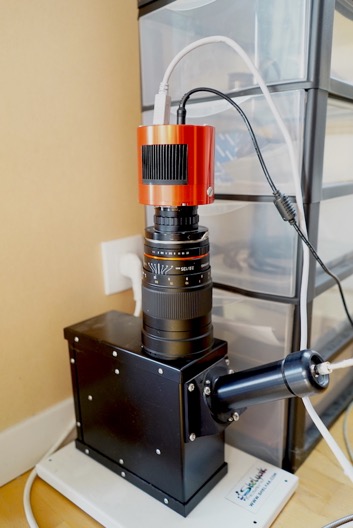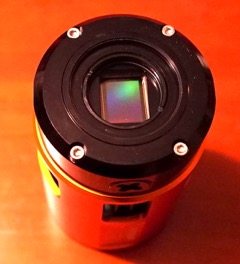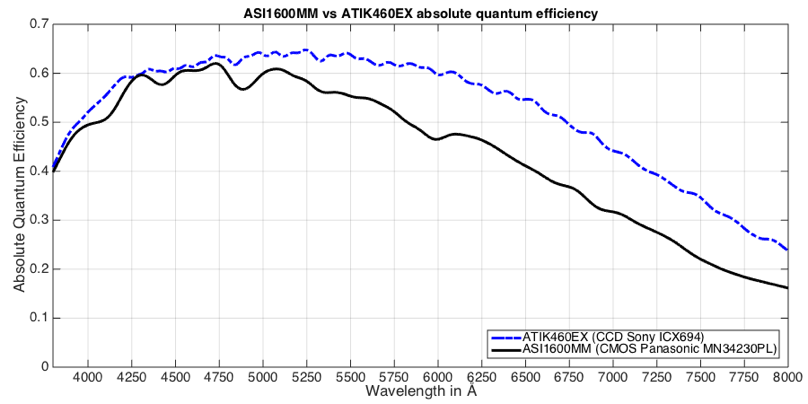Comparison of ATIK HORIZON and ASI1600MM/PRO cameras
by Christian Buil
January 2018

Comparison of two high sensitivity CMOS camera models: the Horizon from Atik and the ASI1600MM/PRO from ZWO. The goal is the evaluation of primary performances of the models in the field of very faint flux detection (spectrographic applications or narrow band deep-sky imaging, for examples).
The compared products integrate the same 16MP 4/3″ 12 bits CMOS sensor: a 4656 x 3520 pixels Panasonic chip (3.8 microns pixel size), here in it’s monochrome version. Compared to ASI1600MM model, Horizon and ASI1600PRO includes a 256MB DDR memory buffer for improve data transfer reliability.


Appearance of the Atik model (left) and the SWO model (rigth) attached to an eShel spectrograph (Shelyak Inst.)
Telescope interface



For the Atik model, a standard M42x0,75 female thread interface. Backfocus: 13 mm.
For the ZWO model, a standard M42x0,75 female thread interface. Backfocus: 16.5 mm.
The ZWO offer possibility to remove the interface ring. For special applications, the backfocus can be reduced to 6.5 mm (male thread).
Computer hardware interface and power

Atik model rear view.

ZWO model rear view.
The two models adopt a fast USB3 computer interface (input line). The Atik connector is a compact USB3.0 Micro B type to carry data and power. The ZWO connector is a more easy to plug and robust USB 3.0 B-Type model.
The Horizon camera must be powered to work (12V). On the other hand, the ASI1600MM / PRO camera can be used without external power supply, but of course only at room temperature in this situation.
Computer software interface
For the test, the cameras are controlled by using Prism software via the ASCOM drivers available at the time of this evaluation (mid-January 2018) without any particular difficulties.

Horizon ASCOM driver interface

ASI1600PRO ASCOM driver interface
(note: the offset parameter is not accessible)

ASI1600MM ASCOM driver interface
It is important to note that the image reading time is strongly computer dependent (here a powerful PC gamer - ideal for managing the large images delivered by this type of camera) or function of USB type interface, driver code efficiency… By using ASCOM, the full frame reading time of the Atik camera is 4.8 seconds while the reading time of the ZWO cameras (both the MM and the PRO version) is 2.3 seconds.
Clearly, the internal 256 Mb DDR3 image buffer gain that make specificities of Horizon and ASI1600MM/PRO models (not present on a ASI1600MM) is not highlighted by the available ASCOM drivers. To give an idea, the full image reading time of the Atik Horizon camera goes to 1.4 second with the Artemis Capture software, and less than 0.5 second with Infinity software (a very impressive speed !).
(Note: at the time of the test, only camera ASI1600MM is supported in direct mode (without having to use the ASCOM driver) by the Prism software (V10.3.33.333) - for a reading duration of 3.5 seconds.)
Optoelectronic performances

Atik Horizon at -18°C
ZWO ASI1600PRO at -18°C


ZWO ASI1600MM at -18°C
All models have very equivalent optoelectronic performances. They can not be distinguished from each other on this point.
Compared to ZWO, Atik adopt a linear relation between the user apparent gain and the effective electronic gain, a more logical and useful choice.
(a remark about CMOS and CCD sensors compared dynamic. For the very popular CCD camera ATIK 460EX, the measured electronic gain is 0.274 e-/ADU, the RON is 5.5 e- and digital coding is on 16 bits, so the true dynamic is 11.67 bits… CMOS technologie is not so ridiculous !)

Dark current
No significant deviation between the models (remember the technical difficulty of measuring this parameter). The performance of the cooling system is also equivalent (nearly -40°C compared to ambient temperature), in particular, the cooling efficiency is the same for the ASI1600MM and the ASI1600PRO.
The following graph compares the absolute quantum efficiency measured by me for an ASI1600MM camera (CMOS detector) and an Atik 460EX camera (CCD detector):

Offset image
High-contrast display of the offset image (a short exposure in the dark) for a same gain (nearly 0.18 e-/ADU) and a same display contrast (ISIS software):

Horizon camera

ASI1600PRO camera

ASI1600MM camera
The observed peak to peak offset level for Horizon and ASI1600PRO is always positive for any electronic gain. This result is not dependent of adopted offset setting value (remember, not accessible for the ASI1600PRO from ASCOM interface). It is a very good news. The ASI1600MM can be marginally affected by a negative values clipping phenomena for high gain, it is one of the rare difference between ASI1600MM and ASI1600PRO models.
Glow image
Appearance of dark 600 second integration time image (T=-20°C), displayed with a very high contrast after a hot pixels removal operation for clarity:

Horizon camera

ASI1600PRO camera

ASI1600MM camera
Comment: The amp-glow artifact is present in all tested models. The addition of a memory buffer (Horizon, ASI1600PRO) does not solve this problem. The intensity of the glow seem proportional to the integration time, not function of data transfert speed (putting out the responsible electronic circuits during the integration time seems impossible).
Flat-field image
By default, the Atik Horizon camera operates with a peculiar electronic shutter mode that continues to integrate incident light during progressive CMOS sensor reading phase (about 67 ms). In this situation, the latest lines of the frame are more exposed to light than the first, which produces a gradient in the final captured image, especially if the exposure time is short. This gradient becomes invisible only when the exposure time is large (more then 5 seconds) relative to the reading time (0.067 second). The result is problematic when one realizes typical flat-field or bright extended surface astronomical images (moon surface for example), most often associated to short exposures. Here a flat-field image for 50 ms integration time (Artemis Capture software) - the vertical gradient is very apparent:

For normal camera use it is mandatory to select the « Even illumination » option (accessible also from the ASCOM interface). If you set this option on, the gradient disappears - in this situation the Atik Horizon camera works properly and in the same way as the ASI1600MM/PRO model:

The ZWO models extend artificially the apparent digital dynamic from 12 bits to 16 bits by multiplying each pixel digital intensity by 16. There is no real interest in this way (do not believe that a 16-bit camera is used !). Atik exploit the same artificial operation if the « Pad Data » option is selected, but there is no problem to switch off the option: the pixel values will range now from 0 to 4095, the naturel values given by the internal CMOS 12-bit ADC.
Conclusion
In summary, all here considered products are great. The optoelectronic performances of the Atik Horizon and ZWO ASI1600MM/PRO cameras are quite similar, and it is hard to select one model or another on this basis.
Some aspects are not considered in this comparison, such as the mechanical finish, dimensions or the detector frost robustness. To be complete, we must also mention the software environment. For example, Atik offers with its camera the Infinity software, not tested by me on the sky, but seems attractive for interactive observations (evolved real time stacking and more).
I propose that the reader make an opinion by himself on these points.